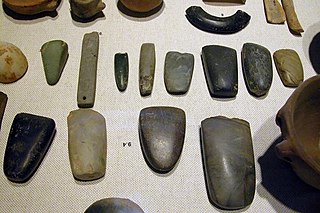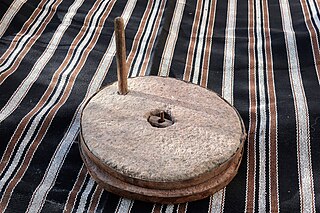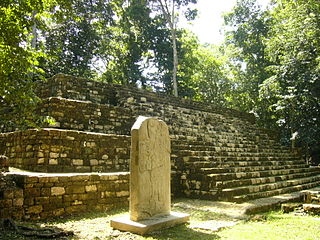
A mano (Spanish for hand) is a ground stone tool used with a metate to process or grind food by hand. [1] It is also known as metlapil, a term derived from Nahuatl. [2]

A mano (Spanish for hand) is a ground stone tool used with a metate to process or grind food by hand. [1] It is also known as metlapil, a term derived from Nahuatl. [2]
Manos were used in prehistoric times to process wild seeds, nuts, and other food, generally used with greater frequency in the Archaic period, when people became more reliant upon local wild plant food for their diet. Later, Manos and metates were used to process cultivated maize. [3]
In its early use in the American Southwest, the mano and metate were used to grind wild plants. The mano began as a one-handed tool. Once the maize cultivation became more prevalent, the mano became a larger, two-handed tool that more efficiently ground food against an evolved basin or trough metate. [4]
Besides food, Manos and metates were used to separate and pulverize clay from earthen debris and stones. The resulting clay was used for pottery-making. [5]

A Mano, a smooth hand-held stone, is used against a metate, typically a large stone with a depression or bowl. The movement of the Mano against the metate consists of a circular, rocking or chopping grinding motion using one or both hands. [6]
Ancient Pueblo People often set up work rooms, called mealing rooms, that were established with sets of manos and metates for mass grinding efforts. [7]

In archaeology, ground stone is a category of stone tool formed by the grinding of a coarse-grained tool stone, either purposely or incidentally. Ground stone tools are usually made of basalt, rhyolite, granite, or other cryptocrystalline and igneous stones whose coarse structure makes them ideal for grinding other materials, including plants and other stones.

Hohokam was a culture in the North American Southwest in what is now part of Arizona, United States, and Sonora, Mexico. It existed between 300 and 1500 CE, with cultural precursors possibly as early as 300 BCE. Archaeologists disagree about whether communities that practiced the culture were related or politically united. According to local oral tradition, Hohokam societies may be the ancestors of the historic Akimel and Tohono Oʼodham in Southern Arizona.

Agriculture in Mesoamerica dates to the Archaic period of Mesoamerican chronology. At the beginning of the Archaic period, the Early Hunters of the late Pleistocene era led nomadic lifestyles, relying on hunting and gathering for sustenance. However, the nomadic lifestyle that dominated the late Pleistocene and the early Archaic slowly transitioned into a more sedentary lifestyle as the hunter gatherer micro-bands in the region began to cultivate wild plants. The cultivation of these plants provided security to the Mesoamericans, allowing them to increase surplus of "starvation foods" near seasonal camps; this surplus could be utilized when hunting was bad, during times of drought, and when resources were low. The cultivation of plants could have been started purposefully, or by accident. The former could have been done by bringing a wild plant closer to a camp site, or to a frequented area, so it was easier access and collect. The latter could have happened as certain plant seeds were eaten and not fully digested, causing these plants to grow wherever human habitation would take them.

Quern-stones are stone tools for hand-grinding a wide variety of materials, especially for various types of grains. They are used in pairs. The lower stationary stone of early examples is called a saddle quern, while the upper mobile stone is called a muller, rubber, or handstone. The upper stone was moved in a back-and-forth motion across the saddle quern. Later querns are known as rotary querns. The central hole of a rotary quern is called the eye, and a dish in the upper surface is known as the hopper. A handle slot contained a handle which enabled the rotary quern to be rotated. They were first used in the Neolithic era to grind cereals into flour.

Hovenweep National Monument is located on land in southwestern Colorado and southeastern Utah, between Cortez, Colorado and Blanding, Utah on the Cajon Mesa of the Great Sage Plain. Shallow tributaries run through the wide and deep canyons into the San Juan River.

A metate is a type or variety of quern, a ground stone tool used for processing grain and seeds. In traditional Mesoamerican cultures, metates are typically used by women who would grind nixtamalized maize and other organic materials during food preparation. Similar artifacts have been found in other regions, such as the sil-batta in Bihar and Jharkhand, India as well as other grinding stones in China.
Oshara Tradition, the northern tradition of the Picosa culture, was a Southwestern Archaic tradition centered in the area now called New Mexico and Colorado. Cynthia Irwin-Williams developed the sequence of Archaic culture for Oshara during her work in the Arroyo Cuervo area of northwestern New Mexico. Irwin contends that the Ancestral Puebloans developed, at least in part, from the Oshara.
Stephen Plog is a notable American archaeologist and anthropologist, who specializes in the pre-Columbian cultures of the American Southwest. As the Commonwealth Professor of Anthropology at The University of Virginia, he currently teaches undergraduate and graduate students, and is working to digitize all the research on the Chaco Canyon through the Chaco Research Archive. On May 1, 2006 he was elected to the National Academy of Sciences. Election to the academy is among the highest distinctions for a scientist, and is based on outstanding and ongoing achievements in original research. He was also a visiting fellow at the School of American Research in Santa Fe, New Mexico in 2001-2002.

Aguateca is a Maya site located in northern Guatemala's Petexbatun Basin, in the department of Petén. The first settlements at Aguateca date to the Late Preclassic period. The center was occupied from about 200 B.C. until about 800 A.D., when the city was attacked and ransacked. Because the city was rapidly abandoned by its population, Pompeii-style assemblages were left scattered on the floors of elite residences. Horizontal excavation of these residences has revealed ancient elite activity and household level craft production areas. Aguateca sits on top of a 90 metres (300 ft) tall limestone bluff, creating a highly defensible position. This steep escarpment overlooks Petexbatun Lagoon in the Southwestern Guatemalan lowlands and is accessible by boat. There is an extensive system of defensive walls that surrounds the city, reaching over 3 miles (4.8 km) in length. Its center consisted on the Palace Group, which was probably a royal residential compound, and the Main Plaza. These monumental complexes were connected by a causeway, along which was a densely occupied elite residential area. During the reign of Tan Te' K'inich the city was invaded and burned. The city was completely abandoned around 830 AD. A 6-metre (20 ft) tall temple at the site was left unfinished, the centre of the city was destroyed by fire, valuables were left scattered in elite residences, and ceramics were left in their original domestic positions, all of which demonstrate the sudden abandonment of the city. The ruins of Aguateca are considered to be among the best preserved in Guatemala.

Aztec cuisine is the cuisine of the former Aztec Empire and the Nahua peoples of the Valley of Mexico prior to European contact in 1519.

A bedrock mortar (BRM) is an anthropogenic circular depression in a rock outcrop or naturally occurring slab, used by people in the past for grinding of grain, acorns or other food products. There are often a cluster of a considerable number of such holes in proximity indicating that people gathered in groups to conduct food grinding in prehistoric cultures. Correspondingly the alternative name gossip stone is sometimes applied, indicating the social context of the food grinding activity. Typical dimensions of the circular indentations are approximately 12 centimeters in diameter by 10 centimeters deep, although a considerable range of depths of the cavities have been documented. The bedrock mortar has been identified in a number of world regions, but has been particularly intensely documented in the Americas. An alternative term for the bedrock mortar site is bedrock milling station.
Prehistory of Colorado provides an overview of the activities that occurred prior to Colorado's recorded history. Colorado experienced cataclysmic geological events over billions of years, which shaped the land and resulted in diverse ecosystems. The ecosystems included several ice ages, tropical oceans, and a massive volcanic eruption. Then, ancient layers of earth rose to become the Rocky Mountains.
The NAN Ranch Ruin site is a Late Pit-house and Classic Mimbres village located along the Mimbres River, at Dwyer, New Mexico and the NAN Ranch was listed on the National Register of Historic Places in 1988. It was occupied by Mimbreños from about 600 to 1140 and is considered an early Mogollon culture site.

The Pueblo I Period was the first period in which Ancestral Puebloans began living in pueblo structures and realized an evolution in architecture, artistic expression, and water conservation.

The Pueblo II Period was the second pueblo period of the Ancestral Puebloans of the Four Corners region of the American southwest. During this period people lived in dwellings made of stone and mortar, enjoyed communal activities in kivas, built towers and dams for water conservation, and implemented milling bins for processing maize. Communities with low-yield farms traded pottery with other settlements for maize.

The Late Basketmaker II Era was a cultural period of Ancient Pueblo People when people began living in pit-houses, raised maize and squash, and were proficient basket makers and weavers. They also hunted game and gathered wild foods, such as pinyon nuts.

The Basketmaker culture of the pre-Ancestral Puebloans began about 1500 BC and continued until about AD 750 with the beginning of the Pueblo I Era. The prehistoric American southwestern culture was named "Basketmaker" for the large number of baskets found at archaeological sites of 3,000 to 2,000 years ago.

The Archaic–Early Basketmaker Era was an Archaic cultural period of ancestors to the Ancient Pueblo People. They were distinguished from other Archaic people of the Southwest by their basketry which was used to gather and store food. They became reliant on wild seeds, grasses, nuts, and fruit for food and changed their movement patterns and lifestyle by maximizing the edible wild food and small game within a geographical region. Manos and metates began to be used to process seeds and nuts. With the extinction of megafauna, hunters adapted their tools, using spears with smaller projectile points and then atlatl and darts. Simple dwellings made of wood, brush and earth provided shelter.

The following outline is provided as an overview of and topical guide to the prehistoric people of Colorado, which covers the period of when Native Americans lived in Colorado prior to contact with the Domínguez–Escalante expedition in 1776. People's lifestyles included nomadic hunter-gathering, semi-permanent village dwelling, and residing in pueblos.
The Apishapa culture, or Apishapa Phase, a prehistoric culture from 1000 to 1400, was named based upon an archaeological site in the Lower Apishapa canyon in Colorado. The Apishapa River, a tributary of the Arkansas River, formed the Apishapa canyon. In 1976, there were 68 Apishapa sites on the Chaquaqua Plateau in southeastern Colorado.